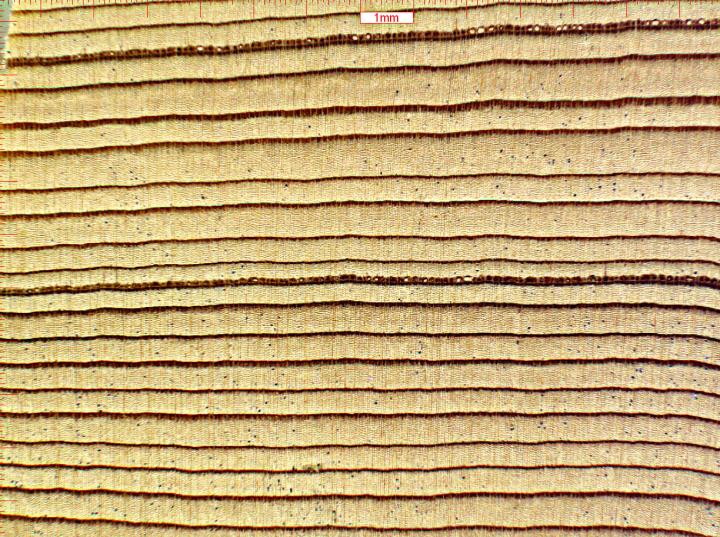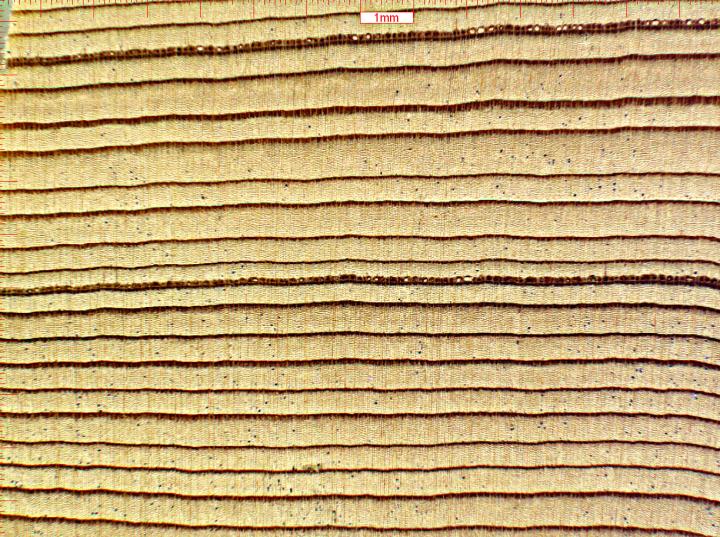
Credit: Image credit: Edgard Espinoza, 2017.
Tackling the problem of illegal logging is particularly challenging as it is often nearly impossible to tell where a piece of wood came from. Now, researchers in Oregon, USA, have developed a technique that uses the chemical fingerprint of a wood sample to pinpoint its origin to a smaller area than ever before.
Endangered species or populations of trees are protected by the Convention on International Trade in Endangered Species of Wild Fauna and Flora (CITES) and the U.S. Lacey Act, which require that imported wood is accompanied by documents that state its species and geographic origin. Unfortunately, these papers are often forged or inaccurate, so a rapid and accurate method of identifying imported wood is critical for law enforcement.
Under a microscope, wood from a particular species has distinguishing characteristics, but it is almost impossible to tell where it came from. This is a problem for species in which only certain populations are protected, such as those in specific countries or large preserves. To tackle this issue, a group of researchers led by Dr. Richard Cronn of the Pacific Northwest Research Station, USDA Forest Service, applied chemical fingerprinting techniques to analyze the molecules in the annual growth rings of Douglas-fir trees (Pseudotsuga menziesii), successfully distinguishing wood from two separate populations of this widespread and economically important species. Their results are published in a recent issue of Applications in Plant Sciences.
The team used a technique called DART-TOFMS (direct analysis in real time time-of-flight mass spectrometry) to measure chemical presence and abundance of Douglas-fir trees from two mountain ranges, the neighboring Oregon Coast and Cascade ranges. The chemical screening only requires a tiny sample of wood, which can be prepared for analysis in just 15 seconds. By comparing the molecular differences of 188 trees, Cronn and his team could tell which region a particular tree came from with a 70-76% accuracy. The technique was previously used to distinguish the wood of closely related species, or populations of the same species from different countries, but this is the first time that DART-TOFMS has been used to identify the source of samples over such small distances (less than 100 km).
Almost 950 molecules were detected in the wood chemical fingerprints. Some compounds could be identified by comparing their profiles with a database of molecules from other conifer tree species, although most compounds could not be identified. Unfortunately, many of these unknown molecules were those that differed between the wood from the two regions, making it difficult to understand why these changes in chemical fingerprint occur. This requires further investigation, says Cronn: "Douglas-fir may be the most important structural timber tree in North America, but we still have much to learn about its wood chemistry."
In timber production, the older, darker heartwood in the center of the tree trunk is particularly valuable, and it was this wood that was investigated in the study. The team analyzed the three oldest annual growth rings shared between all of the samples, which grew in 1986 to 1988. While they did not find any conclusive differences between the three years, it is possible that extreme weather events could lead to more dramatic differences between the chemical fingerprints of some annual rings, and the authors conclude that more extensive sampling is required.
Building on this work, Cronn and his colleagues are now attempting to discover whether the differences in the chemical fingerprints of the Douglas-fir trees arise from genetic differences between the populations, environmental differences, or a combination of the two. To answer this question, they will compare trees with identical genetic backgrounds that have been planted in different environments. Either outcome will offer new opportunities for forest research, as Cronn explains: "If wood chemical profiles are primarily determined by the environment, we could use this technique to predict the climate in which a tree was growing. If chemical profiles are mainly determined by genetics, this kind of analysis could be used as a rapid screen for determining genetic differences."
Cronn hopes that this work on Douglas-fir will be used to protect a wider range of trees in the future: "We hope the wood forensics community will take what we learn from this regionally abundant tree and apply it to hardwood and softwood species that are the targets of illegal logging and the focus of conservation efforts."
###
This study was funded by the USDA Forest Service Pacific Northwest Research Station and Forest Service International Programs.
Kristen Finch, Edgard Espinoza, F. Andrew Jones, and Richard Cronn. 2017. Source identification of western Oregon Douglas-fir wood cores using mass spectrometry and random forest classification. Applications in Plant Sciences 5(5): 1600158. doi:10.3732/apps.1600158.
Applications in Plant Sciences (APPS) is a monthly, peer-reviewed, open access journal focusing on new tools, technologies, and protocols in all areas of the plant sciences. It is published by the Botanical Society of America, a nonprofit membership society with a mission to promote botany, the field of basic science dealing with the study and inquiry into the form, function, development, diversity, reproduction, evolution, and uses of plants and their interactions within the biosphere. APPS is available as part of BioOne's Open Access collection.
For further information, please contact the APPS staff at [email protected].
Media Contact
Beth Parada
[email protected]
@Botanical_
http://www.botany.org
############
Story Source: Materials provided by Scienmag





